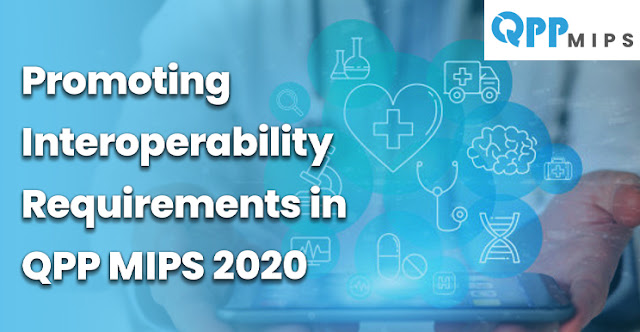Promoting Interoperability Requirements in QPP MIPS 2020 Reporting Services
Promoting Interoperability (PI) in QPP MIPS is all about technology incorporation in the healthcare industry to empower patients and making information transmission easy. Certified electronic health record technology (CEHRT) is the most appreciated medium to achieve this.
Each year, CMS changes some of its requirements and policies to better facilitate physicians. In the performance year 2020, some of the requirements are also changed.
Here is an overview of everything related to promoting interoperability in MIPS 2020.
Final Score Percentage
This category has a total of 25 points in the final MIPS score.
Changes can be expected due to hardship exceptional applications and other special statuses, reweighting other categories.
What Data is to be submitted for this Category?

Eligible physicians are required to submit data and measures that translate the 2015 version of CEHRT.
PI has the following four objectives and the submitted data should translate these objectives.
What are the Requirements for PI QPP MIPS 2020?
2015 Edition CEHRT is the most important feature to participate in the ongoing MIPS year for PI. The data is to be submitted for consecutive ninety or more days with the following objectives unless there is an exception.
Alongside the related data, CMS requires the physicians’ EHR CMS Identification code from the Certified Health IT Product List (CHPL).
Moreover, physicians or MIPS Qualified Registries on their behalves must submit an affirmative response to the following categories.
· The prevention of information blocking attestation
· The ONC direct review confirmation
· The security risk analysis
What are the Hardship Exceptions?

In case, eligible physicians are unable to report for this category, they can apply for the hardship exception for any of the following reasons.
· If the clinician works in a small practice
· If the clinician uses decertified EHR technology
· No or Insufficient Internet connectivity
· Extreme and uncontrollable circumstances
· Lack of control over the availability of CEHRT
If the reason is accepted by the CMS, the weight of this category will be distributed to another category or categories (Quality, Improvement Activities (IA), & Cost), unless the stream less data submission.
Some types of clinicians such as physical therapists, occupational therapists, or clinical psychologists don’t need to apply for an exception for this category. They receive special status for QPP MIPS reporting; therefore, their percentage will automatically be reweighted.
Another requirement is that from groups or virtual groups, all participants must qualify for the reweight unless the group is exempted by a special status.
How to Submit Data?
For promoting interoperability performance year, there are three methods to submit data.
· Attestation method via sign up
· Upload data via sign up
· Direct submission via API
However, the submission method depends upon the submitter type. The following table shows the details of the data submission.
Submitter Type | Sign up & Upload | Sign up & Upload | Direct Submission via API |
MIPS eligible clinician | Allowed | Allowed | Not Allowed |
Any representative on behalf of medical practice or virtual group | Allowed | Allowed | Not Allowed |
Third-party Intermediaries | Not Allowed | Allowed | Allowed |
How CMS Scores PI measures?
CMS scores every measure by multiplying the performance rate by the available points of the measure. The Public Health and Clinical Data Exchange awards full points if data is submitted for two registries or one registry with one exclusion.
Eligible clinicians should report all necessary required measures, i.e. submit data for at least one patient in the numerator, as applicable, or exclusion. Otherwise, clinicians can receive zero points.
If groups or eligible clinicians claim exclusions, points of those measures are reallocated to other measures.
How to Get Bonus Points?

If clinicians or MIPS Qualified Registries report data for the optional measure, Query of Prescription Drug Monitoring (PDMP), they can earn 5 bonus points in this category.
This is some of the information that clinicians need to know for reporting the promoting interoperability category in QPP MIPS. If you have participated for four years, you would be updated with the changes for MIPS 2020 reporting, otherwise, you can consult a MIPS Qualified Registry for maximum benefits. For more details, visit, https://qppmips.com/
You must be thinking that it is long before the MIPS 2020 reporting, we can start later on, but with the on-going crisis, clinicians who would start planning today would be benefitted more with accurate data submission and ultimately, more points.
The Quality Payment Program (QPP) under the Medicare Access and CHIP Reauthorization Act (MACRA) emphasizes the importance of interoperability in healthcare. For the 2020 reporting year, the Promoting Interoperability (PI) performance category plays a crucial role in the Merit-based Incentive Payment System (MIPS). Here’s a breakdown of the requirements and their significance.
Understanding Promoting Interoperability
Promoting Interoperability aims to enhance patient care by ensuring seamless data exchange among healthcare providers. It promotes the use of certified electronic health record technology (CEHRT) to facilitate effective communication and improve healthcare outcomes.
Key Requirements for 2020
For MIPS 2020, providers must report on specific measures to fulfill the PI category:
1. Use of CEHRT
Healthcare providers must utilize CEHRT that meets the 2015 Edition certification criteria. This ensures that the technology supports interoperability standards.
2. Reporting Measures
Providers need to report on a minimum of four measures, which include:
- e-Prescribing: Measure how effectively you send prescriptions electronically.
- Health Information Exchange: Demonstrate the ability to send and receive patient information with other providers.
- Patient-Specific Education: Provide patients with tailored educational resources based on their health conditions.
- Provider to Patient Exchange: Facilitate patients' access to their health information.
3. Required Objectives
The PI category has specific objectives that must be met, including:
- Secure Messaging: Encourage the use of secure messaging to communicate with patients.
- Patient Access: Ensure patients can easily access their health data online.
4. Performance Scoring
MIPS uses a scoring system to evaluate the performance in the PI category. Providers can earn up to 40 points based on their performance in the required measures.
Read More: Things Physicians for Medicare Payment 2020 in MIPS Reporting Services
Importance of Interoperability
Interoperability is vital in today’s healthcare landscape, enabling better care coordination and improved patient outcomes. By promoting data sharing, healthcare providers can reduce duplicate testing, enhance patient safety, and ultimately improve the quality of care.
Conclusion
The Promoting Interoperability requirements in QPP MIPS 2020 are essential for healthcare providers aiming to enhance patient care through effective data exchange. Understanding and meeting these requirements not only boosts performance scores but also contributes to the broader goal of achieving a more integrated healthcare system.
FAQs
What is the main goal of Promoting Interoperability?
- To enhance patient care through effective data exchange among healthcare providers.
How many measures must be reported for PI in 2020?
- A minimum of four measures must be reported.
What is CEHRT?
- Certified Electronic Health Record Technology, which meets specific certification criteria.
How are performance scores calculated in the PI category?
- Providers can earn up to 40 points based on their performance in required measures.
Why is interoperability important in healthcare?
- It improves care coordination, reduces duplicate testing, and enhances overall patient safety.
Labels: MIPS 2020, MIPS 2020 reporting, MIPS consultancy, MIPS in healthcare, MIPS Qualified Registries, MIPS Quality Measures, QPP MIPS, QPP MIPSMIPS 2020





